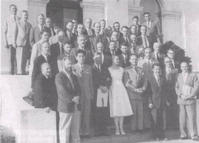


Memories of the Bureau, 1946 to 1962
Foreword
Terminology
Prologue
Preface
Chapter 1: The Warren Years, 1946 to 1950
Chapter 2: International Meteorology
Chapter 3: The Timcke Years, 1950 to 1955
Chapter 4: A Year at the Massachusetts Institute of Technology
Chapter 5: The Dwyer Years, 1955 to 1962
Leonard Joseph Dwyer—A Complex Character
Reorganising the Bureau
Public Weather Services
Forecasts for the General Public
Importance of Radio Stations
The Advent of Television
Automatic Telephone Forecast Service
Beacons
Wording and Verification of Forecasts
Warnings
Services for Aviation
Atomic Weapons Tests
Atomic Weapons Tests—Mosaic G1 and G2
Atomic Weapons Tests—Buffalo 1, 2, 3 and 4
Atomic Weapons Tests—Operations Antler, 2 and 3
Atomic Weapons Tests—Minor Trials
Instruments and Observations
Radiosondes
Radar/Radio Winds and Radar Weather Watch
Automatic Weather Stations
Sferics
Meteorological Satellites
Telecommunications
Tropical Cyclones
Bureau Conference on Tropical Cyclones
International Symposium on Tropical Cyclones, Brisbane
Hydrometeorology
Design of Water Storages, Etc
Flood Forecasting
Cloud Seeding
Reduction of Evaporation
Rain Seminar
Cloud Physics
Fire Weather
Research and Special Investigations
International Activities
The International Geophysical Year
The Antarctic and Southern Ocean
International Symposium on Antarctic Meteorology
International Antarctic Analysis Centre
ADP, EDP and Computers
Training
Publications
Management Conference
Services Conference
CSIRO and the Universities
Achievements of the Dwyer Years
Chapter 6: A Springboard for the Future
Appendix 1: References
Appendix 2: Reports, Papers, Manuscripts
Appendix 3: Milestones
Appendix 4: Acknowledgements
Appendix 5: Summary by H. N. Warren of the Operation of the Meteorological Section of Allied Air Headquarters, Brisbane, 1942–45
Endnotes
Index
Search
Help
Contact us

International Symposium on Antarctic Meteorology
The Australian delegation to the meetings of CSAGI and SCAR in Moscow in July and August 1958 had extended invitations to other delegations to attend a symposium on Antarctic meteorology in Melbourne in February 1959. Len Dwyer was a keen supporter of the idea that the Bureau should take the initiative in organising such a symposium and with the endorsement of the Australian Academy of Science, CSAGI and SCAR, it was not too difficult for him to secure Government approval for the expenditure required. Len designated me as chairman of the Bureau group organising the symposium.
The efforts of a wide range of people in the Bureau's Central Office were necessary to plan the program of the symposium, arrange the accommodation and facilities, develop a schedule of social activities including an official reception and a barbecue in the Dandenong ranges and preprint a program which included abstracts in English, French and Russian of all papers to be presented. Much of this work was accomplished by Frank Hannan, Gwynne Wilson and Val Phillips, members of the Bureau's Central Office staff.
The symposium held from 18 to 25 February 1959 at the Royal Society of Victoria was attended by 70 participants, one each from Argentina, Belgium, Japan, South Africa and WMO, two from the USSR, three from France, four from New Zealand, five each from the UK and US and the balance from other nations.
Antarctic veterans included Dr F Debenham and Sir Raymond Priestley, members of the Scott Polar Expedition of 1910 to 1913, and Captain J. K. Davis and Dr B. Stilwell of Sir Douglas Mawson's Australian Antarctic Expeditions. Dr Kaare Langlo represented WMO, and Dr G. de Q. Robin, the Scott Polar Research Institute, Cambridge.
People in Bright Sparcs - Davis, John King; Dwyer, Leonard Joseph; Mawson, Douglas; Priestley, Charles Henry Brian (Bill)
 |
Bureau of Meteorology |  |
© Online Edition Australian Science and Technology Heritage Centre and Bureau of Meteorology 2001
Published by Australian Science and Technology Heritage Centre, using the Web Academic Resource Publisher
http://www.austehc.unimelb.edu.au/fam/1116.html